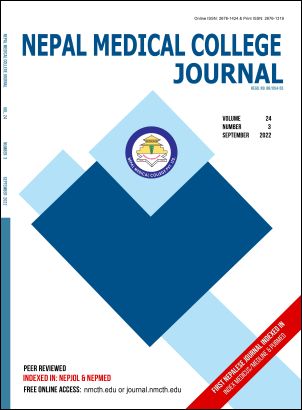Ocular disorders and associated factors among the first year health professional students at a medical college in Kathmandu
DOI:
https://doi.org/10.3126/nmcj.v24i3.48595Keywords:
Ocular disorders, health professional students, refractive errors, dry eye diseaseAbstract
The human eye is an important organ as it provides sight and proper coordination in various tasks. The function of the eye is mediated by the 2nd cranial nerve or the optic nerve. Damage to any part of the optic nerve usually results in poor vision, dyschromatopsia (colour blindness), diminished sensitivity to bright light, poor contrast sensitivity, defective afferent pupillary and visual field defects. The commonest ocular disorders are usually attributed to refractive errors such as: myopia, hypermetropia and astigmatism. A healthy eye is necessary for a conducive learning and teaching environment in any academia. Eye screening to rule out any ocular disorder is of utmost importance, especially in medical education, because these students need to be detected early and treated on time to ensure their optimal academic work. Therefore, this study was attempted to determine the proportion of visual disorders among the first year health professional students at Nepal Medical College, and to identify factors associated with it. A total of 115 students were enrolled for this study, where males accounted for 51.3%, while females accounted for 48.7%, respectively. The minimum age was 18 years and maximum was 23 years, with a mean of 19.69 years, and a standard deviation of ±1.14. Almost eight out of ten students (78.3%) had some form of ocular disorders, with many of them having more than one disorder. Females outnumbered the males (51.1%; 48.9%) with respect to the occurrence of eye disorders. The commonest eye disorders were: refractive errors in 60 (52.7%) students, followed by dry eye disease in 23 (20.0%) students, cataract in 2 (1.7%) students, Duane’s retraction syndrome in 1, color vision defect in 1 student and 2 students had other manifestations. Based on ethnicity, slightly more than half of the participants were Khas-Aryans (60.0%), while Adibasi-Janjatis and Madhesis had similar participation of 20.9% and 19.1% respectively. More than three quarters of the participants were MBBS students (82.6.%), followed by BDS students (13.0%) and BSc Nursing students (4.4%). The association between ocular disorders and gender was not statistically significant(p value = 0.35). However, a statistically significant association was observed between gender and refractive errors (p value=0.002). There was no association observed between the status of students’ refractive error and parental status of refractive error (p value =0.099)
Downloads
Downloads
Published
How to Cite
Issue
Section
License
Copyright (c) 2022 Nepal Medical College Journal

This work is licensed under a Creative Commons Attribution 4.0 International License.
This license enables reusers to distribute, remix, adapt, and build upon the material in any medium or format, so long as attribution is given to the creator. The license allows for commercial use.




